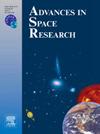Active solar eclipse avoidance on the distant retrograde orbit of the Earth-Moon system
IF 2.8
3区 地球科学
Q2 ASTRONOMY & ASTROPHYSICS
引用次数: 0
Abstract
Lighting condition is a significant concern for spacecraft because it is directly related to their power and thermal subsystems. For spacecraft moving on a Distant Retrograde Orbit (DRO) of the Earth-Moon System, the lighting condition is severe because the DRO faces frequent long-duration solar eclipses. This study proposes a solar eclipse avoidance strategy for DRO missions. First, the lighting condition on a stable nominal DRO is analyzed, which reveals that long-duration solar eclipses are inevitable and active avoidance maneuvers are essential. Then, a close-loop three-impulse maneuver strategy is developed to deviate the trajectory from the nominal DRO and avoid a single shadow region of the Earth (or the Moon). The analytical solution of the first velocity impulse required for orbit correction at an arbitrary position is derived. The optimal position of imposing the velocity impulse is obtained using a nonlinear programming-based optimization algorithm. Finally, a coordinated shadow avoidance algorithm is proposed to simultaneously avoid the shadow of the Earth and the Moon. Simulations show that the proposed strategy successfully keeps the flying trajectory outside the shadow regions in a 4-year mission time at an average annual velocity impulse cost of 46.936 m/s.
求助全文
约1分钟内获得全文
求助全文
来源期刊

Advances in Space Research
地学天文-地球科学综合
CiteScore
5.20
自引率
11.50%
发文量
800
审稿时长
5.8 months
期刊介绍:
The COSPAR publication Advances in Space Research (ASR) is an open journal covering all areas of space research including: space studies of the Earth''s surface, meteorology, climate, the Earth-Moon system, planets and small bodies of the solar system, upper atmospheres, ionospheres and magnetospheres of the Earth and planets including reference atmospheres, space plasmas in the solar system, astrophysics from space, materials sciences in space, fundamental physics in space, space debris, space weather, Earth observations of space phenomena, etc.
NB: Please note that manuscripts related to life sciences as related to space are no more accepted for submission to Advances in Space Research. Such manuscripts should now be submitted to the new COSPAR Journal Life Sciences in Space Research (LSSR).
All submissions are reviewed by two scientists in the field. COSPAR is an interdisciplinary scientific organization concerned with the progress of space research on an international scale. Operating under the rules of ICSU, COSPAR ignores political considerations and considers all questions solely from the scientific viewpoint.
 求助内容:
求助内容: 应助结果提醒方式:
应助结果提醒方式:


